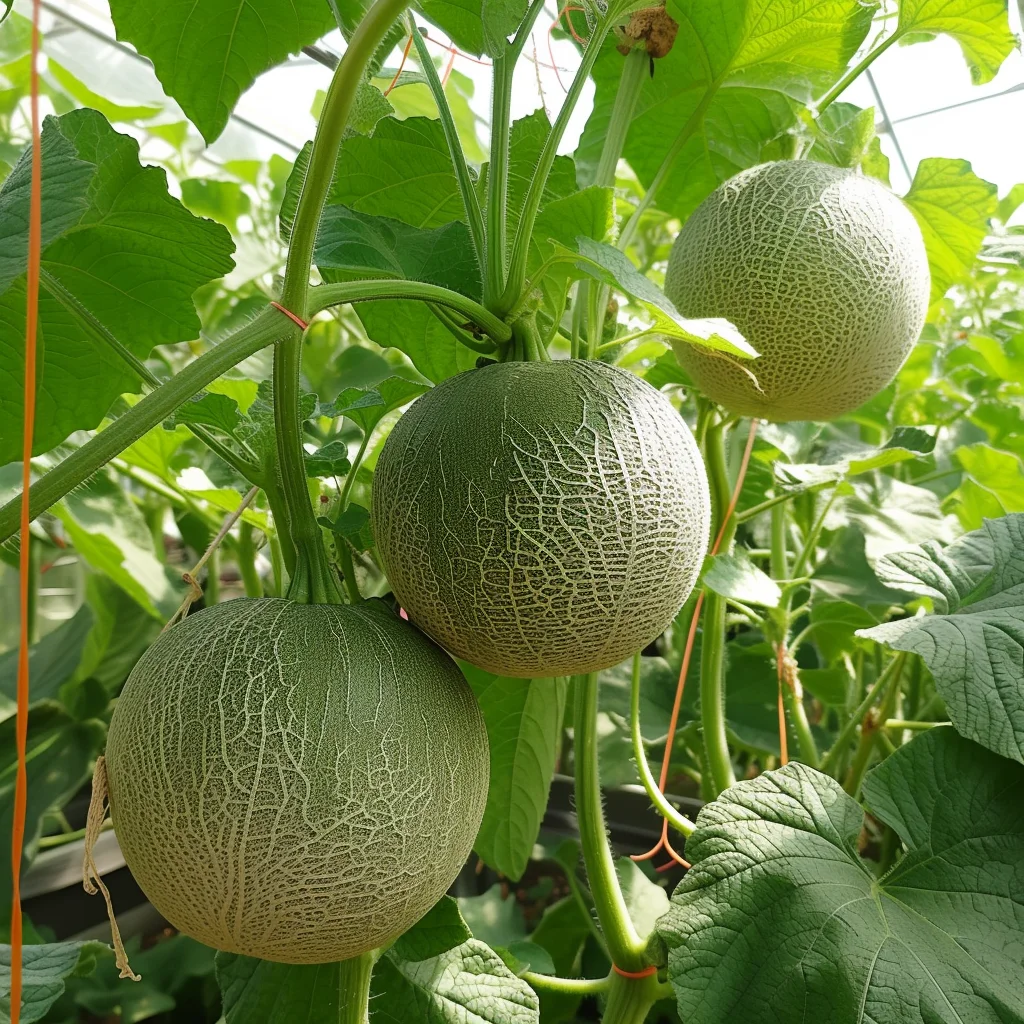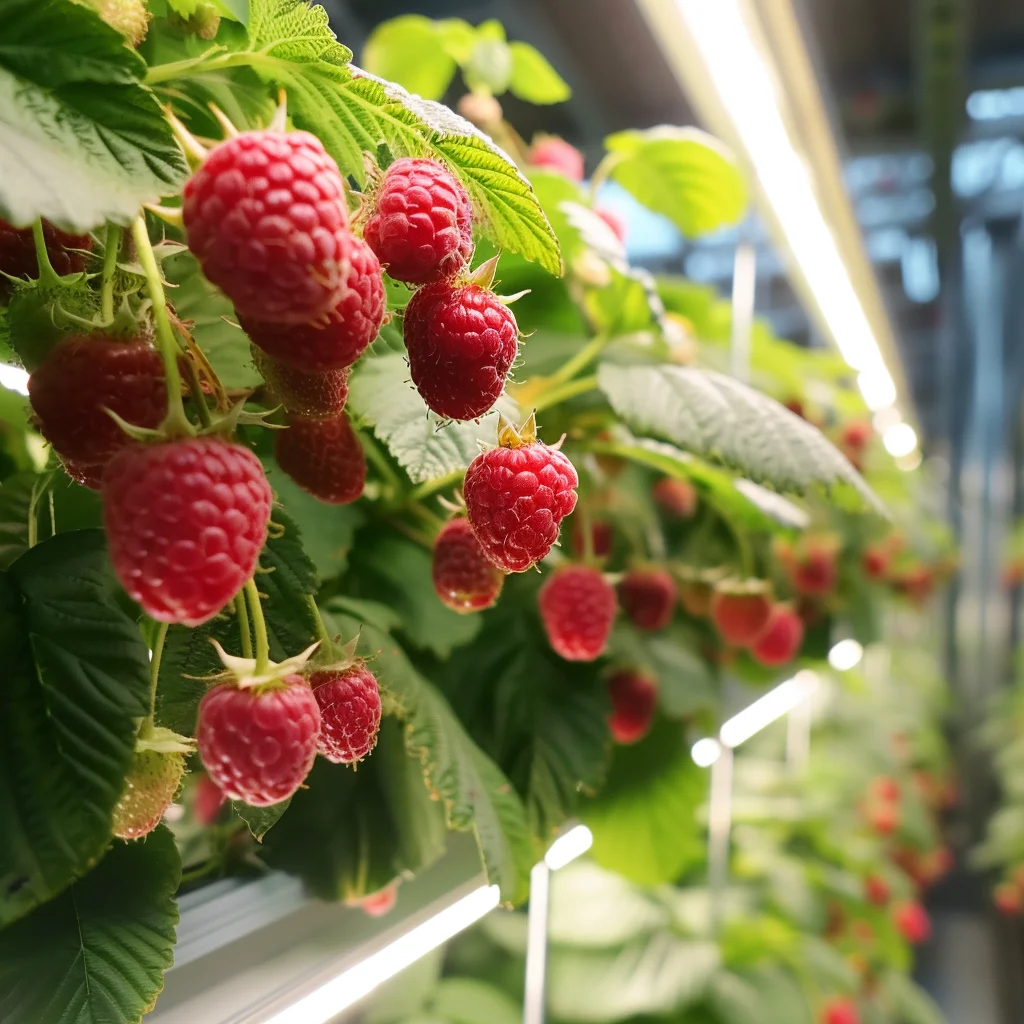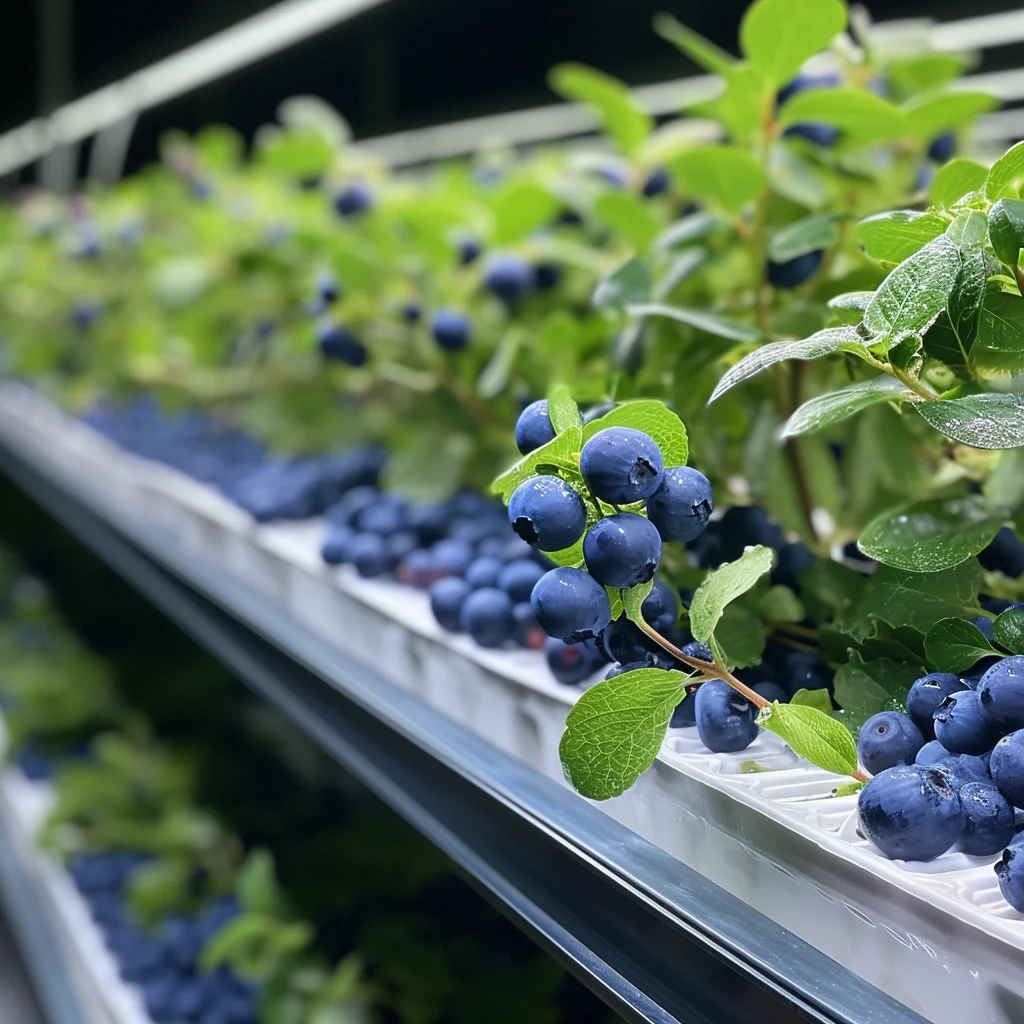Introduction
Hydroponics is the innovative method of growing plants without soil, using nutrient-rich water solutions instead. With hydroponics, growers are able to provide the precise amounts of nutrients, water, and environmental conditions that plants need for optimal growth and fruit production. This level of control over the inputs and environment leads to faster growth rates, higher yields, less disease pressure, and healthier plants compared to traditional soil gardening.
When set up properly, many types of plants can be successfully grown hydroponically, including popular fruits like melons. Melons require warm temperatures, lots of space, and heavy feedings to reach their full potential. By growing melons hydroponically instead of in traditional in-ground soil, you can maximize their growth, yields, and flavor.
In this complete guide “Can I Grow Melons Hydroponically?”, we’ll cover everything you need to know about choosing melon varieties suited for hydroponics, setting up your system, caring for your plants throughout the season, and harvesting an abundant melon crop without the use of soil. Follow these tips and you’ll be enjoying sweet, juicy homegrown melons in no time.
Choosing the Right Melon Varieties for Hydroponics
Not all melon varieties perform the same when grown hydroponically. While most types can be grown hydroponically, some are better suited for these soilless systems than others.
Here are some of the best melon varieties to grow hydroponically:
Cantaloupe
One of the most popular melons, known for its sweet orange flesh and musky aroma. Cantaloupe thrives in hydroponic setups. Look for varieties like Athena, Aphrodite, and Savor.
Honeydew
Produces sweet, crisp white flesh. Grows well hydroponically but needs a long summer season to fully mature. Try Earlidew or Orangedew varieties.
Watermelon
With its juicy red flesh, watermelon is a hot weather favorite. Compact, bush-type varieties work best for hydroponics like Sugar Baby and Mickylee.
Canary Melon
Yields tangy, moist yellow melons in a compact plant size. Perfect for hydro systems. Look for Tasty Bites.
Galia Melon
Exotic netted melons with refreshing orange flesh. Prefers warm, humid conditions making it a good hydroponics candidate.
Charentais Melon
Fragrant French melon good for cool climates. Thrives hydroponically in greenhouse settings. Nikita is a top variety.
When choosing a melon variety for hydroponics, consider its preferred growing conditions. Cantaloupe, Galia, and Charentais love warmer greenhouse temperatures between 70-90°F making them ideal for indoor hydroponic gardens. Other types like watermelon and honeydew need a long summer season with plenty of sunny warmth to fully mature.
Make sure to select compact, bush-type varieties with smaller vines that won’t outgrow your hydroponic system. Larger, vining varieties can be trained in hydroponic systems but require more space and pruning. Miniature ‘personal sized’ melons are also great compact choices.
Stick to this list of recommended varieties to ensure success growing melons hydroponically.
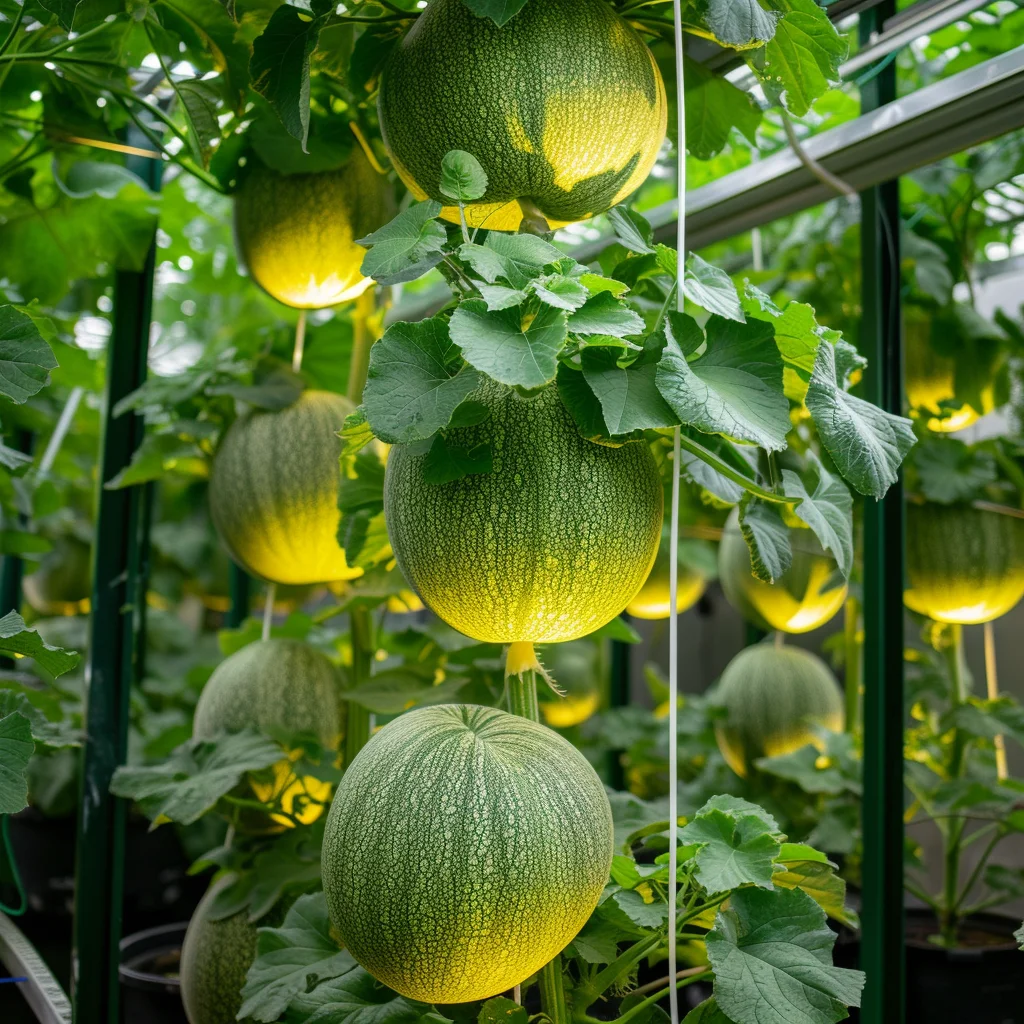
Setting Up Your Hydroponic System
To grow melons hydroponically, you need to setup a system that will provide the roots with oxygen while bathing them in a nutrient-rich solution. There are several types of hydroponic systems that can successfully grow melons:
NFT (Nutrient Film Technique)
NFT systems use channels or pipes that constantly flow a thin film of nutrient solution across the roots. The channels are set on a gentle slope to allow the water to drain so no stagnant puddles form. The constant flow of fresh water oxygenates the roots while providing nutrients and water. NFT systems are great for vining crops like melons that need to spread out.
Drip Hydroponics
In drip systems, the nutrient solution is delivered directly to the root zone through drippers and tubing. A timer controls the frequency and duration of the drips throughout the day. Less water is used compared to NFT systems since the roots are not immersed. The wet-dry cycles promote healthy roots.
Raft Hydroponics
Also known as float systems, plants sit in holes of polystyrene rafts that float in channels filled with nutrient solution. The roots dangle freely below the rafts suspended in the water for maximum exposure. Less oxygen reaches the roots compared to NFT and drip systems.
Ebb and Flow (Flood and Drain)
The plants sit in a planting tray. The nutrient solution floods the tray on a timer, wetting the roots, then drains away. As the roots dry out between floods oxygen is replenished.
No matter what hydroponic system you choose, there are some basic components you’ll need:
- Reservoir – Holds the nutrient solution
- Growing beds, panels, channels, pipes – Holds the plants
- Air pump and stones – Oxygenates the water
- Water pump – Circulates the water
- Tubing – Transports the water
- Timer – Controls watering schedule
- pH and EC Meters – Monitors solution
For lighting, LED grow lights work well indoors providing the full light spectrum melons need. Outdoors, choose a sunny location for best growth.
Invest in a water chiller to maintain the ideal temperature range for melons of 70-80°F. The nutrient solution should be kept at an EC of 2.0-2.5 and a pH of 5.5-6.0 when growing melons hydroponically.
Following these guidelines when setting up your system will give your melon plants the environment they need to flourish.
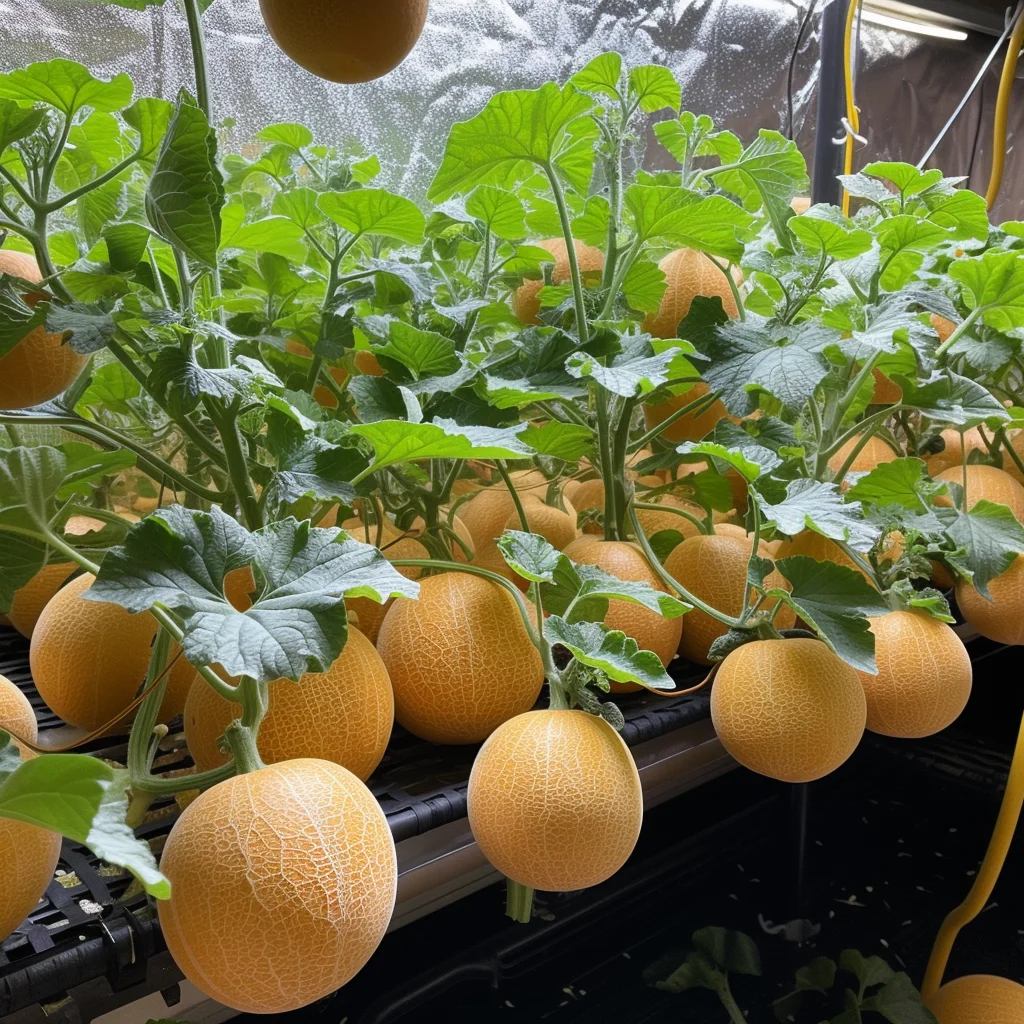
Planting and Caring for Melon Plants
Melons can be started from seed or transplanted as seedlings into your hydroponic system. Direct sow seeds in starter plugs or rockwool cubes. Place young plants in the growing channels or beds, spacing 12-18 inches apart for bush varieties and 24-36 inches for vining melons.
Prune off secondary vines, leaving just a few main leaders. Guide the vines along trellises or wrap them carefully around the edges of the growing bed. This saves space and prevents tangled plants.
flowers form before the female flowers. To ensure good pollination and fruit set, hand pollinate using a small brush. Collect pollen from male flowers and dab it onto the female flowers. Each flower only opens for one day so check daily.
Provide the nutrient levels recommended for hydroponic melons throughout the growing season for healthy plants. Test and adjust the pH and EC regularly.
Melons grow quickly under the ideal hydroponic conditions. Fruits will form 50-80 days after planting. Support large fruits like watermelons with fabric slings.
Common pests like aphids, whiteflies and spider mites can become a nuisance in indoor gardens. Scout for them regularly and use organic sprays like insecticidal soap or neem oil at the first sight of an infestation.
Diseases like powdery mildew and root rot can also plague melons. Maintain proper air circulation and run your pump periodically to oxygenate the roots. Spray foliage with potassium bicarbonate or neem oil to prevent disease issues.
With attentive care and optimal growing conditions, hydroponic melons grow strong and stay pest and disease free.
When and How to Harvest Melons
Melons take 65-95 days to reach maturity and full flavor, depending on variety. Cantaloupes mature on the earlier side while watermelons and honeydews take longer.
Monitor your fruits as they near maturity and look for these signs they are ready for harvesting:
- Rind color changes from green to tan/yellow/orange
- Rind feels firm and firefighter to the touch
- Tendril near fruit stem is shriveled and dead
- Melon sounds hollow and deep when thumped
- Aromatic sweet smell
Use a pair of clean, sharp pruners to carefully cut melons from the vines. Be careful not to damage nearby fruits that may still be growing.
Handle melons gently to avoid bruising. Hydroponically grown melons have thinner rinds than soil grown ones. Move fruits to a shaded area on garden carts or wheelbarrows to prevent sunburn.
Store freshly picked melons for 1-2 weeks at 45-50°F with high humidity. Allow melons to fully ripen at room temperature for 1-2 days before eating for the best flavor.
With the perfect hydroponic environment, you can expect bountiful yields of at least 1-2 melons per plant! Taste testing your homegrown hydroponic melons is the best reward for all your hard work setting up and maintaining your system.
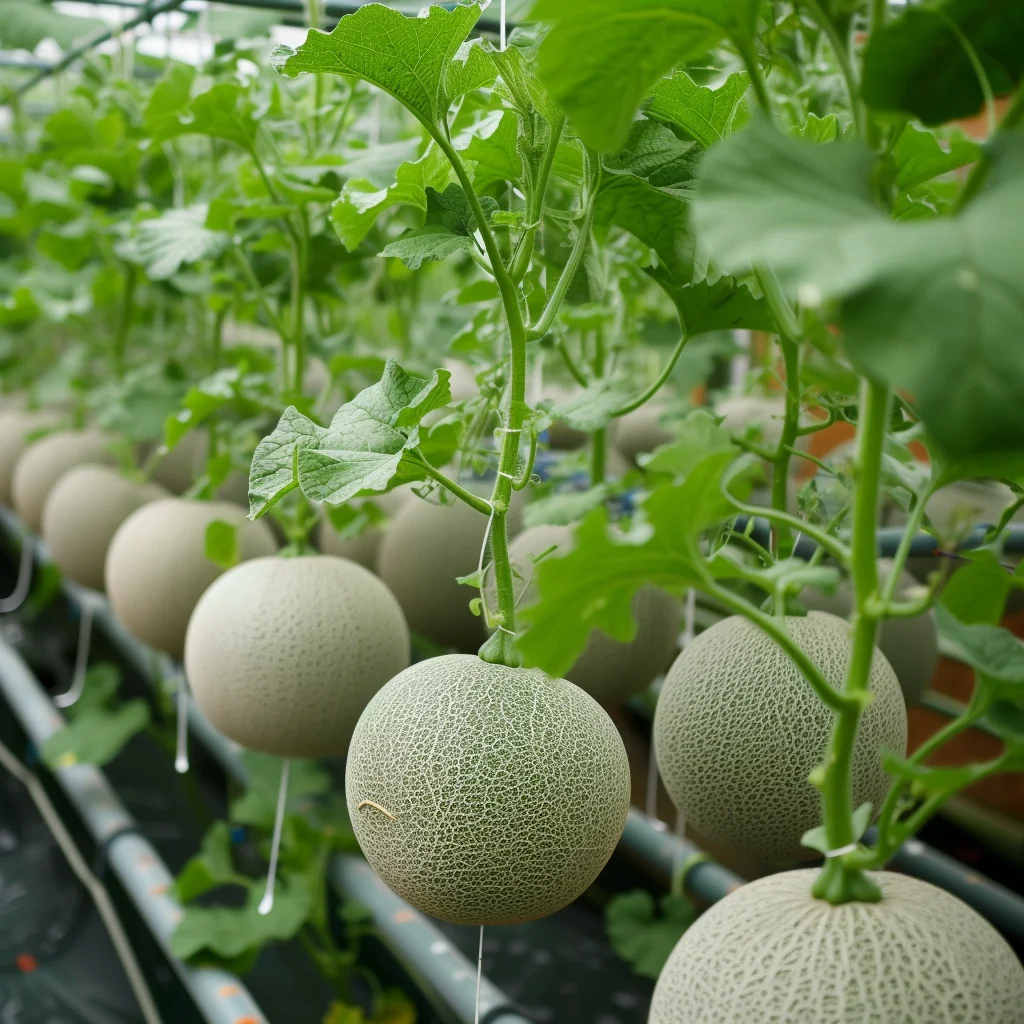
Hydroponic Melons: Troubleshooting Problems
Even with ideal conditions, you may run into a few issues while growing melons hydroponically. Here are some common problems and how to fix them:
Leggy seedlings – Increase light intensity, lower temperatures
Slow growth – Raise EC levels, check pH
Poor pollination & lack of fruit – Hand pollinate, use bees, tap flowers
Small fruits – Increase light and EC levels
Nutrient deficiencies – Look for yellow leaves, test water, supplement nutrients
Algae growth – Block light to reservoir, change water frequently
Clogged drip lines – Flush lines with water and scrub emitters
Root rot – Oxygenate water more, lower EC
Powdery mildew – Improve air flow, use organic antifungal sprays
With attentive care and quick troubleshooting, you can overcome any issues that arise.
Tips for Maximizing Hydroponic Melon Yields
Here are some additional tips to maximize your melon yields:
- Start plants in late winter for an early spring harvest
- Maintain daytime temperatures of 75-85°F and nighttime temps above 60°F
- Vegetative stage plants need 18 hours of light per day
- Once fruiting, cut light back to 12-14 hours
- Prune plants leaving just a few main vines so energy goes to fruit rather than leaves
- Trellis vines for better light exposure and air circulation
- Pollinate female flowers daily for complete fruit set
- Use mycorrhizae and beneficial bacteria to enhance nutrient absorption
- Avoid wetting plant leaves to prevent disease; just water roots
- Flush hydro system every 2 weeks to prevent salt buildup
Following these best practices will lead to sweeter, fuller hydroponic melons.
Conclusion
Hydroponics unlocks the full potential of melons by giving you complete control over their growing environment. With the ability to perfectly tailor water, nutrients, lighting, temperatures, and other inputs, hydroponically grown melons thrive.
By choosing compact varieties suited to hydroponics, setting up an efficient system, caring for plants attentively, and harvesting at peak ripeness, you can enjoy bountiful yields of juicy, flavorful melons. No more bland grocery store melons – homegrown hydroponic melons are sweet as candy!
Follow this complete guide and you’ll be amazed at the successful melon harvests from your hydroponic garden. Get your system set up today and look forward to fresh melons all season long!
